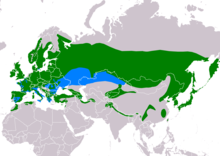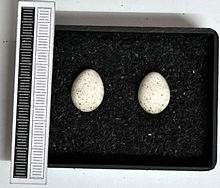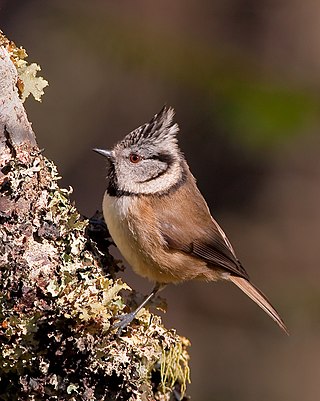
The tits, chickadees, and titmice constitute the Paridae, a large family of small passerine birds which occur mainly in the Northern Hemisphere and Africa. Most were formerly classified in the genus Parus.

The ground tit, Tibetan ground-tit or Hume's ground-tit is a bird of the Tibetan plateau north of the Himalayas. The peculiar appearance confused ornithologists in the past who called it as Hume's groundpecker and still later as Hume's ground jay or Tibetan ground jay assuming that it belonged to the family Corvidae that includes the crows and jays. Although morphologically confusing, the species has since been identified using molecular sequence comparisons as being a member of the tit family (Paridae) and is the only species in the genus Pseudopodoces. It is found in the Tibetan Plateau of China, India, Nepal & Bhutan.

The marsh tit is a Eurasian passerine bird in the tit family Paridae and genus Poecile, closely related to the willow tit, Père David's and Songar tits. It is a small bird, around 12 cm (4.7 in) long and weighing 12 g (0.42 oz), with a black crown and nape, pale cheeks, brown back and greyish-brown wings and tail. Between 8 and 11 subspecies are recognised. Its close resemblance to the willow tit can cause identification problems, especially in the United Kingdom where the local subspecies of the two are very similar: they were not recognised as separate species until 1897.
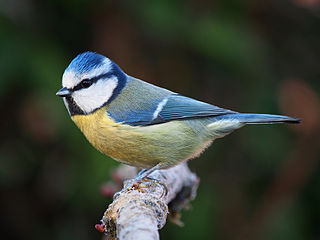
The Eurasian blue tit is a small passerine bird in the tit family, Paridae. It is easily recognisable by its blue and yellow plumage and small size.

The crested tit or European crested tit, is a passerine bird in the tit family Paridae. It is a widespread and common resident breeder in coniferous forests throughout central and northern Europe and in deciduous woodland in France and the Iberian peninsula. In Great Britain, it is chiefly restricted to the ancient pinewoods of Inverness and Strathspey in Scotland, and seldom strays far from its haunts. A few vagrant crested tits have been seen in England. It is resident, and most individuals do not migrate.

The great tit is a passerine bird in the tit family Paridae. It is a widespread and common species throughout Europe, the Middle East, Central Asia and east across the Palearctic to the Amur River, south to parts of North Africa where it is generally resident in any sort of woodland; most great tits do not migrate except in extremely harsh winters. Until 2005 this species was lumped with numerous other subspecies. DNA studies have shown these other subspecies to be distinct from the great tit and these have now been separated as two distinct species, the cinereous tit of southern Asia, and the Japanese tit of East Asia. The great tit remains the most widespread species in the genus Parus.

The long-tailed tit, also named long-tailed bushtit, is a common bird found throughout Europe and the Palearctic. The genus name Aegithalos was a term used by Aristotle for some European tits, including the long-tailed tit.

The black-capped chickadee is a small, nonmigratory, North American passerine bird that lives in deciduous and mixed forests. It is a member of the Paridae family, also known as tits. It has a distinct black cap on its head, a black bib underneath, and white cheeks. It has a white belly, buff sides, and grey wings, back, and tail. The bird is well known for its vocalizations, including its fee-bee call and its chick-a-dee-dee-dee call, from which it derives its name.

The grey-headed chickadee or Siberian tit, formerly Parus cinctus, is a passerine bird in the tit family Paridae. It is a widespread resident breeder throughout subarctic Scandinavia and the northern Palearctic, and also into North America in Alaska and the far northwest of Canada. It is a conifer specialist. It is resident, and most birds do not migrate. Curiously, the bird has no grey on its head, which is black, white, and brown.
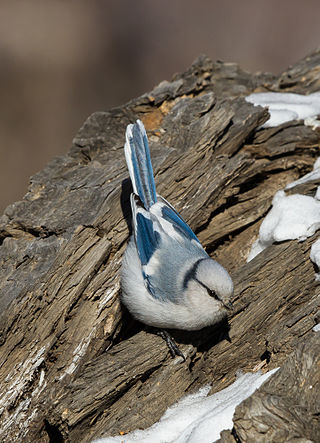
The azure tit is a passerine bird in the tit family Paridae. It is a widespread and common resident breeder throughout Russia, Central Asia, northwest China, Manchuria, and Pakistan.

The rufous-naped tit, also known as the black-breasted tit or dark-grey tit, is an Asian songbird species in the tit and chickadee family (Paridae). It was sometimes considered conspecific with the rufous-vented tit, and was formerly placed in the genus Parus.

The white-winged black tit is a passerine bird in the tit family Paridae. It is also known as the white-winged tit, dark-eyed black tit or northern black tit. The species was first described by Eduard Rüppell in 1840.

The sultan tit is an Asian forest bird with a yellow crest, dark bill, black upperparts plumage and yellow underparts. The sexes are similar. The female has greenish-black upperparts and a yellowish throat. The young bird is duller than the adult and has a shorter crest. It is the only member of the monotypic genus Melanochlora, which is fairly distinct from the Parus tits with the nearest relative being the monotypic Sylviparus.

The grey tit is a species of bird in the tit family Paridae. It is found in Lesotho and South Africa. Its natural habitats are subtropical or tropical dry shrubland and Mediterranean-type shrubby vegetation.

Parus is a genus of Old World birds in the tit family. It was formerly a large genus containing most of the 50 odd species in the family Paridae. The genus was split into several resurrected genera following the publication of a detailed molecular phylogenetic analysis in 2013. The genus name, Parus, is the Latin word for "tit".

The black-crested tit, also known as the spot-winged tit, is a bird in the family Paridae. It was formerly considered a species, but is now widely considered a subspecies of the coal tit.

The rufous-vented tit is an Asian songbird species in the tit and chickadee family (Paridae). Some of its subspecies were formerly assigned to its western relative the rufous-naped tit, or these two were considered entirely conspecific.

Poecile is a genus of birds in the tit family Paridae. It contains 15 species, which are scattered across North America, Europe and Asia; the North American species are the chickadees. In the past, most authorities retained Poecile as a subgenus within the genus Parus, but treatment as a distinct genus, initiated by the American Ornithologists Union, is now widely accepted. This is supported by mtDNA cytochrome b sequence analysis.
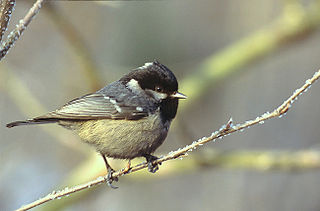
Periparus is a genus of birds in the tit family. The birds in the genus were formerly included in Parus but were moved to Periparus when Parus was split into several resurrected genera following the publication of a detailed molecular phylogenetic analysis in 2005. The name Periparus had been introduced for a subgenus of Parus that included the coal tit by the Belgium naturalist Edmond de Sélys Longchamps in 1884. The genus name, is Ancient Greek peri plus the pre-existing genus Parus.
In the 10th edition of Systema Naturae, published in 1758, the Swedish naturalist Carl Linnaeus described 554 species of bird and gave each a binomial name.

